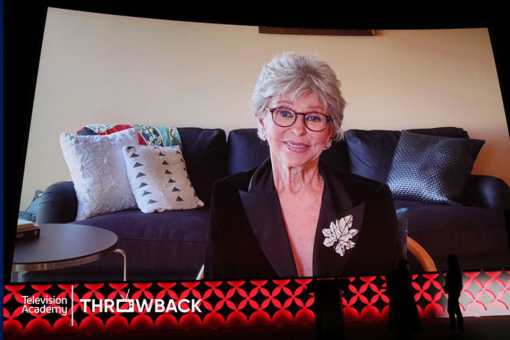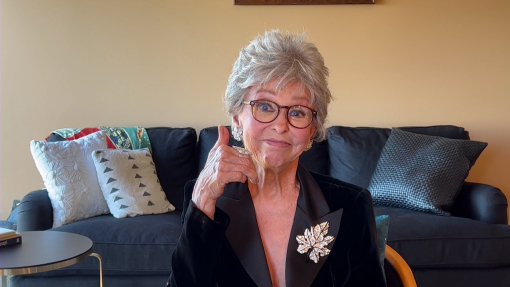“Making people laugh was what I enjoyed doing,” says Sheldon Leonard, whose stable of sitcoms dominated primetime television during the 1950s, 1960s and 1970s. Leonard’s classics, which ranked in the Top 10 shows during the mid-1960s, include The Andy Griffith Show; The Dick Van Dyke Show; Gomer Pyle, U.S.M.C.; Mayberry, R.F.D.; and The Danny Thomas Show.
An unequaled 17 pilots directed by Leonard were sold as series, and he was the creative producer responsible for I Spy, The Real McCoys, Lassie, My Favorite Martian, The Joey Bishop Show, The Bill Dana Show, and many others.
Born in 1907 on Manhattan’s Upper East Side, Leonard attended Syracuse University on an athletic scholarship. “I had been guaranteed a job in the stock-brokerage business upon my graduation,” Leonard remembers, “but my timing was extraordinarily bad because when I graduated in 1929 Wall Street went into a decline and I had to look around for another job. The only skill I had was some experience acting in amateur productions.”
Leonard made his professional acting debut as a heavy in the 1932 Caribbean adventure film Drums in the Night. A role in the national touring company of the Broadway comedy Three Men and a Horse established his forte in comedy. George Abbott soon recognized Leonard’s talents, and he went on to appear in more than a dozen Broadway comedies throughout the 1930s.
“Broadway gave me a familiarity with comedy that is simply unobtainable these days,” Leonard says. “I had the opportunity to try out various aspects of comedy on literally thousands of live audiences and find out why they laugh and how to sustain, encourage and control the laugh. That’s what is called ‘timing,’ which is nothing more than familiarity with how audiences react.”
Playwright Marc Connelly hired Leonard as a script reader in the late 1930s. “That work laid the foundation for what became my career,” Leonard says, “because in reading, analyzing and critiquing these plays, I learned a little about construction and how faults could be identified and corrected.”
Leonard directed touring companies of Broadway comedies before moving to Hollywood in 1939 for a role in Another Thin Man. During the 1940s, he appeared in more than 140 films and became a regular player on several radio programs, including those hosted by Bob Hope, Phil Harris, Judy Canova, Ann Sothern, Fred Allen, and others.
On Jack Benny’s radio program he appeared frequently as a Runyonesque character, whose opening line — “Hey, bud” — became one of radio’s enduring taglines. He also wrote radio plays, and in 1955 adapted one for television’s Jeweler's Showcase.
“Television was starving for material in those days,” Leonard remembers, “and no self-respecting writer would bother selling a script to television for $350. But I had no shame. I sold a second script to Jeweler's Showcase, but I made the condition that I was to direct it.”
Leonard soon became the director of Danny Thomas’ show, Make Room for Daddy, and a pioneering and accomplished three-camera director. In 1957, Leonard blazed the trail for the rural comedies that became so popular when he helped develop The Real McCoys and directed the pilot. During his partnership with Thomas, he also devised television’s first “spin-off” sitcom when Andy Griffith appeared as the sheriff of Mayberry on Thomas’ show.
In 1961, Leonard read a series of scripts that Carl Reiner had written about a trio of television comedy writers working for a neurotic star that became The Dick Van Dyke Show.
“I learned how to be a producer by watching what Sheldon did,” Reiner says. “I came to him as an actor who wrote, and he told me to produce the Van Dyke show. When he read my scripts he said, ‘You should produce it.’ I said, ‘I don’t know how to produce,’ and he said, ‘Yes, you do.’ That was all he said, ‘Yes, you do,’ and I was producing.
“Sheldon has mentored more people in our business than anyone else I know. He knew how to teach what he knew, and what he knew was situation comedy with the three-camera technique. Sheldon was a producing genius who understood comedy. He had four or five shows going, but he would walk in and give his intelligence and his time to every script that was being read for the week. And we always came away with a better script because we would discuss and argue and come to a better situation.
“He kept all of us on our toes. If you disagreed with him, you’d have a wonderful fight, but he was a worthy adversary and the fights were always creative. He would always keep us thinking.”
Garry Marshall, who worked with Leonard as a writer on The Joey Bishop Show and The Dick Van Dyke Show, says, “I was amazed when I met him for the first time, because he talked just like he did on Jack Benny’s show. He was the first executive I ever met who had an accent. Sheldon had a serious demeanor because of the way he talked, but he could make you laugh whenever he wanted to by going into that Jack Benny character. As an actor, he had the ability to make you listen. He could go from kidding-around comedy to top executive.
“And you knew you couldn’t push him around because he could still do the gangster character and you always had one little drop of doubt in your mind that possibly in his pocket he had a gun. You never were sure with Sheldon. Once he liked you, he helped you creatively, logistically and executively — and he could always pull out that gun for you.
“He most influenced me in his attraction to characters that were real human beings, not just cartoon-comedy figures. Even someone like Gomer Pyle, who is quite an over-the-top kind of character, always had a warm, poignant side to him.
“Sheldon was a sort of man’s man, yet he had all the creative sensitivity of the artist. No matter what story you were working on, he could help you fix it. He would never put down your idea. If I had to describe Sheldon in one word it would be gentleman. He was a Renaissance man with a New York accent — and possibly a gun!”
In 1965, Leonard developed I Spy, shot largely on location overseas. “I Spy grew out of my desire to open up television and enlarge it,” says Leonard. “I wanted something other than enclosed sets and blank walls.”
Starring Robert Culp and Bill Cosby, I Spy was the first dramatic series to feature a black actor. “I saw Culp, and he was the actor I wanted,” Leonard remembers. “I saw Cosby, and he was the other actor I wanted. Network executives were scared to death that the Southern stations would not accept a black actor in a leading role. They asked questions like, ‘They’re actually going to sleep together in the same room and double date together?’ But it turned out not to be a problem. I got lucky.
Now writing anecdotal memoirs that trace his 60 years in show business, Leonard says, “I was driven by an urge to survive and being very self-indulgent. I never did anything for very long that I didn’t like or enjoy. I would survive only on my own terms. I had to enjoy what I was doing, and I would have done what I did even if nobody paid me. That’s the secret of success in any business: do it well and enjoy doing it.”
This tribute originally appeared in the Television Academy Hall of Fame program celebrating Sheldon Leonard's induction in 1992.












